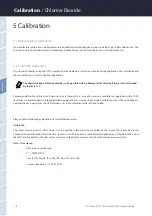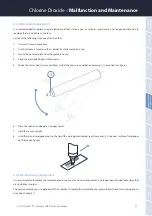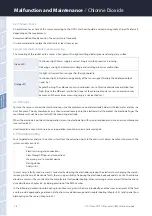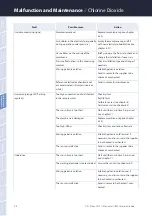
16
Us
e
Us
e
Calibr
ation
Calibr
ation
M
alfunc
tion and
M
ain
tenanc
e
M
alfunc
tion and
M
ain
tenanc
e
Comm-
issioning
Comm-
issioning
In
tr
oduc
tion
In
tr
oduc
tion
G
ener
al
Inf
or
ma
tion
G
ener
al
Inf
or
ma
tion
FA
Q
FA
Q
Technical
Da
ta
Technical
Da
ta
W
ar
ran
ty
W
ar
ran
ty
Cust
omer
ser
vic
e
Cust
omer ser
vic
e
Con
tac
t
Con
tac
t
Key
w
or
d
Inde
x
Key
w
or
d
Inde
x
Ac
cessor
ies
Ac
cessor
ies
D01-915en201911 Manual eCHEM Chlorine Dioxide
Malfunction and Maintenance
//
Chlorine Dioxide
6 Malfunction and Maintenance
To ensure error-free and reliable measurement, the chlorine dioxide sensor should be cleaned and serviced at regular intervals.
When carrying out maintenance and in the event of a malfunction, the entire system from the extraction point to the drain
must always be taken into account. The system usually consists of:
•
Chlorine dioxide sensor
•
Electrical wiring and connections
•
Flow-through fittings and connections
•
Measuring and / or control device
•
Dosing device
•
Analysis kit
Before removing the sensor, downstream controllers should be switched off or switched to manual operation. If the sensor is
removed, an incorrect measured value may occur at the input of the controller and lead to uncontrolled dosing in a control
loop. Shut off the sample water inlet and outlet. Remove the electrical connection.
6.1 Cleaning and Upkeep
To ensure a long service life of the chlorine dioxide sensor, it should be checked regularly for contamination. Carefully rinse
off any soiling on the outside with water. In case of heavy soiling it is recommended to change the gel electrolyte and/or the
membrane cap. A detailed description on how to change the gel electrolyte and the membrane cap is given in the following
chapter 6.2.
If you have further questions on this topic, we would be pleased to help you. Please contact our customer service at support@
trios.de.
6.2 Maintenance and inspection
The sensor should be checked regularly for contamination, fouling and bubbles on the outside of the membrane. Avoid con-
tamination of the membrane with particles, condensation etc. as far as possible. Bubbles on the outside of the membrane can
be eliminated by briefly increasing the flow rate.
After a membrane cap or electrolyte change, a slope adjustment must be carried out.
The use of warm water is recommended for rinsing off the gel electrolyte residues on the electrode finger
and in the membrane cap.
The coating of the electrode finger must not be sanded down. Do not unscrew the membrane disc
holder from the membrane cap, as the membrane may be damaged and the adjustment may be lost!
NOTICE






























